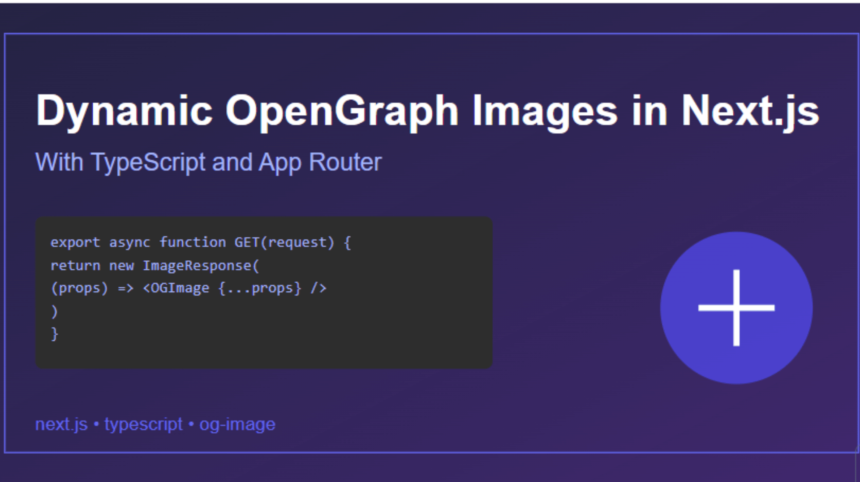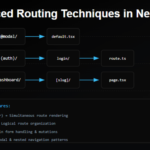Dynamic OpenGraph images can significantly boost your content’s social media presence and engagement. This comprehensive guide will show you how to implement dynamic OG image generation in Next.js 14+ using the App Router and TypeScript.
Understanding Dynamic OpenGraph Images
OpenGraph images are preview images that appear when sharing links on social media platforms. Dynamic OG images are generated on-demand based on your content, providing fresh and contextual previews for your shared links.
Project Setup
First, create a new Next.js project with TypeScript:
npx create-next-app@latest dynamic-og-nextjs --typescript --tailwind --app
cd dynamic-og-nextjs
npm install @vercel/ogImplementation Steps
1. Create the OpenGraph Route Handler
// app/api/og/route.tsx
import { ImageResponse } from '@vercel/og'
import { NextRequest } from 'next/server'
export const runtime = 'edge'
export async function GET(request: NextRequest) {
try {
const { searchParams } = new URL(request.url)
// Get title from search params
const title = searchParams.get('title')
return new ImageResponse(
(
<div
style={{
height: '100%',
width: '100%',
display: 'flex',
flexDirection: 'column',
alignItems: 'center',
justifyContent: 'center',
backgroundColor: '#fff',
padding: '40px',
}}
>
<h1
style={{
fontSize: '64px',
fontWeight: 'bold',
color: '#000',
textAlign: 'center',
}}
>
{title || 'Default Title'}
</h1>
</div>
),
{
width: 1200,
height: 630,
}
)
} catch (error) {
console.error('Error generating OG image:', error)
return new Response('Failed to generate image', { status: 500 })
}
}2. Create OpenGraph Metadata Types
// types/og.ts
export interface OGImageParams {
title: string
subtitle?: string
theme?: 'light' | 'dark'
template?: 'default' | 'blog' | 'product'
}
export interface OGMetadata {
title: string
description: string
image: string
url: string
}3. Implement the OpenGraph Component
// components/OGImage.tsx
import React from 'react'
import { OGImageParams } from '@/types/og'
interface Props {
style?: React.CSSProperties
params: OGImageParams
}
export function OGImage({ style, params }: Props) {
const { title, subtitle, theme = 'light' } = params
const bgColor = theme === 'light' ? '#ffffff' : '#000000'
const textColor = theme === 'light' ? '#000000' : '#ffffff'
return (
<div
style={{
height: '100%',
width: '100%',
display: 'flex',
flexDirection: 'column',
alignItems: 'center',
justifyContent: 'center',
backgroundColor: bgColor,
padding: '40px',
...style,
}}
>
<h1
style={{
fontSize: '64px',
fontWeight: 'bold',
color: textColor,
textAlign: 'center',
}}
>
{title}
</h1>
{subtitle && (
<p
style={{
fontSize: '32px',
color: textColor,
opacity: 0.8,
textAlign: 'center',
marginTop: '20px',
}}
>
{subtitle}
</p>
)}
</div>
)
}4. Add Dynamic Metadata Generation
// app/[slug]/page.tsx
import { Metadata } from 'next'
import { generateOGMetadata } from '@/utils/metadata'
interface Props {
params: { slug: string }
}
export async function generateMetadata({ params }: Props): Promise<Metadata> {
const post = await getPost(params.slug) // Your data fetching logic
return {
title: post.title,
description: post.description,
openGraph: {
title: post.title,
description: post.description,
images: [{
url: `${process.env.NEXT_PUBLIC_URL}/api/og?title=${encodeURIComponent(post.title)}`,
width: 1200,
height: 630,
}],
},
}
}
export default function PostPage({ params }: Props) {
// Your page component
}5. Create a Metadata Utility
// utils/metadata.ts
import { OGMetadata } from '@/types/og'
export function generateOGMetadata(data: Partial<OGMetadata>): OGMetadata {
const baseUrl = process.env.NEXT_PUBLIC_URL || 'http://localhost:3000'
return {
title: data.title || 'Default Title',
description: data.description || 'Default Description',
image: data.image || `${baseUrl}/api/og?title=${encodeURIComponent(data.title || '')}`,
url: data.url || baseUrl,
}
}6. Implement Template System
// components/templates/BaseTemplate.tsx
import React from 'react'
import { OGImageParams } from '@/types/og'
export interface TemplateProps {
params: OGImageParams
style?: React.CSSProperties
}
export function BaseTemplate({ params, style }: TemplateProps) {
return (
<div
style={{
height: '100%',
width: '100%',
position: 'relative',
...style,
}}
>
{/* Base template content */}
</div>
)
}7. Create Custom Templates
// components/templates/BlogTemplate.tsx
import { TemplateProps } from './BaseTemplate'
export function BlogTemplate({ params, style }: TemplateProps) {
const { title, subtitle, theme = 'light' } = params
return (
<div
style={{
height: '100%',
width: '100%',
display: 'flex',
flexDirection: 'column',
padding: '60px',
background: theme === 'light' ? '#ffffff' : '#000000',
...style,
}}
>
<div style={{ flex: 1 }}>
<h1
style={{
fontSize: '72px',
fontWeight: 'bold',
color: theme === 'light' ? '#000000' : '#ffffff',
lineHeight: 1.2,
}}
>
{title}
</h1>
{subtitle && (
<p
style={{
fontSize: '36px',
color: theme === 'light' ? '#666666' : '#cccccc',
marginTop: '20px',
}}
>
{subtitle}
</p>
)}
</div>
{/* Add your blog template specific elements here */}
</div>
)
}8. Add Font Loading Support
// utils/fonts.ts
import { fetchFont } from '@vercel/og'
export async function loadFonts() {
const interRegular = await fetchFont({
family: 'Inter',
weight: 400,
text: 'abcdefghijklmnopqrstuvwxyzABCDEFGHIJKLMNOPQRSTUVWXYZ0123456789.,!?-_/\\',
})
const interBold = await fetchFont({
family: 'Inter',
weight: 700,
text: 'abcdefghijklmnopqrstuvwxyzABCDEFGHIJKLMNOPQRSTUVWXYZ0123456789.,!?-_/\\',
})
return { interRegular, interBold }
}9. Implement Caching
// app/api/og/route.tsx
import { ImageResponse } from '@vercel/og'
import { NextRequest } from 'next/server'
export const runtime = 'edge'
// Enable caching for production
export async function GET(request: NextRequest) {
try {
const response = await generateOGImage(request)
// Cache for 1 hour in production
if (process.env.NODE_ENV === 'production') {
response.headers.set(
'Cache-Control',
'public, max-age=3600, s-maxage=3600, stale-while-revalidate=3600'
)
}
return response
} catch (error) {
console.error('Error generating OG image:', error)
return new Response('Failed to generate image', { status: 500 })
}
}10. Add Error Handling
// utils/error.ts
export class OGImageError extends Error {
constructor(
message: string,
public statusCode: number = 500
) {
super(message)
this.name = 'OGImageError'
}
}
export function handleOGImageError(error: unknown) {
if (error instanceof OGImageError) {
return new Response(error.message, { status: error.statusCode })
}
console.error('Unexpected error:', error)
return new Response('Internal Server Error', { status: 500 })
}11. Implement Image Optimization
// utils/optimization.ts
interface OptimizationOptions {
quality?: number
format?: 'jpeg' | 'png'
}
export function getOptimizedImageConfig(options: OptimizationOptions = {}) {
const { quality = 90, format = 'png' } = options
return {
width: 1200,
height: 630,
embedFont: true,
debug: process.env.NODE_ENV === 'development',
format,
quality,
}
}12. Add Rate Limiting
// middleware.ts
import { NextResponse } from 'next/server'
import type { NextRequest } from 'next/server'
const rateLimit = {
windowMs: 60 * 1000, // 1 minute
max: 100 // limit each IP to 100 requests per windowMs
}
const inMemoryStore = new Map()
export function middleware(request: NextRequest) {
if (request.nextUrl.pathname.startsWith('/api/og')) {
const ip = request.ip ?? '127.0.0.1'
const now = Date.now()
const timestamps = inMemoryStore.get(ip) || []
// Clean old requests
const recentTimestamps = timestamps.filter(
(timestamp: number) => now - timestamp < rateLimit.windowMs
)
if (recentTimestamps.length >= rateLimit.max) {
return new NextResponse('Too Many Requests', { status: 429 })
}
recentTimestamps.push(now)
inMemoryStore.set(ip, recentTimestamps)
}
return NextResponse.next()
}13. Environment Configuration
// .env.local
NEXT_PUBLIC_URL=http://localhost:3000
NEXT_PUBLIC_OG_IMAGE_WIDTH=1200
NEXT_PUBLIC_OG_IMAGE_HEIGHT=63014. Testing Setup
// __tests__/og.test.tsx
import { render } from '@testing-library/react'
import { OGImage } from '@/components/OGImage'
describe('OGImage', () => {
it('renders with default props', () => {
const { container } = render(
<OGImage
params={{
title: 'Test Title',
}}
/>
)
expect(container).toBeInTheDocument()
})
it('renders with custom theme', () => {
const { container } = render(
<OGImage
params={{
title: 'Test Title',
theme: 'dark',
}}
/>
)
expect(container).toBeInTheDocument()
})
})15. Usage Example
// app/page.tsx
import { Metadata } from 'next'
export const metadata: Metadata = {
title: 'My Website',
description: 'Welcome to my website',
openGraph: {
title: 'My Website',
description: 'Welcome to my website',
images: [{
url: '/api/og?title=Welcome to my website',
width: 1200,
height: 630,
}],
},
}
export default function HomePage() {
return (
<div>
<h1>Welcome to my website</h1>
{/* Your page content */}
</div>
)
}Conclusion
Dynamic OpenGraph images can significantly improve your content’s social media presence. By following this guide, you’ve learned how to implement a robust OG image generation system using Next.js App Router and TypeScript. Remember to optimize for performance and implement proper error handling for production use.







